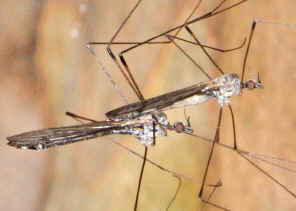Spider Web Crane Fly - ? sp.
Crane Flies - Family Tipulidae
This page contains pictures and information about Spider Web Crane Flies that we found
in the Brisbane area, Queensland, Australia.

- Body length 20mm
- Sometimes we see a group of Crane Flies resting on the tangled spider webs on large tree trunk, including webs of Comb-footed Spider. Obviously, they are not captured by the spider web for they can fly away freely. They seem just resting on there to gain protection from the spider web.


- Usually a group of them can be found. They look like giant mosquitoes. They are long-legged and long-winged with slender body.


- However, not like mosquitoes, they do not feed on blood. Crane flies only drink water but do not feed at adult stage.
- Crane Fly also called 'Daddy-long-legs', with long and thin legs. Their legs are not for walking but to hang from spider web.



- The Crane Fly is also found resting on large smooth bark tree trunk. This fly can hardly be seen when resting on tree trunk because of its thin body and camouflaged colours.



- When came closer, the Crane Fly will vibrate its body in a very high speed and became almost invisible.















- Reference:
- 1. Insects of Australia - CSIRO, Division of Entomology, Melbourne University Press, 2nd Edition 1991, p740.
